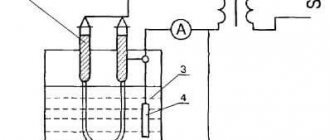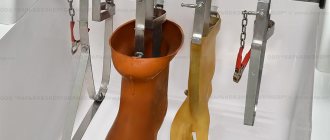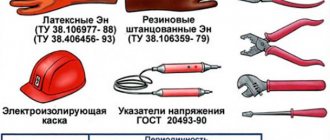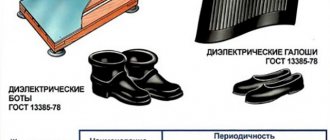Home › Documentation
“ How should protective equipment that fails the test be labeled? "
❌ The test stamp must be crossed out with red paint.
Test frequency
| Name of the remedy | Periodicity |
| Dielectric boots | Once every 36 months. (3 years) |
| Dielectric galoshes | Once every 12 months. (1 year) |
| Dielectric gloves | Once every 6 months (1\2 years) |
| Insulating tool up to 1000 V | Once every 12 months. (1 year) |
| Indicators up to and above 1000 V | Once every 12 months. (1 year) |
| Insulating rods | Once every 24 months (2 years) |
| Insulating pliers | Once every 24 months (2 years) |
| Clamp meter | Once every 24 months (2 years) |
| Insulating part of portable grounding rods with metal links | Once every 24 months (2 years) |
The instructions contain a classification and list of protective equipment for work in electrical installations, requirements for their testing, content and use.
The Instructions contain standards and methods for operational, acceptance and type testing of protective equipment, procedures and standards for equipping electrical installations and production teams with protective equipment.
The instruction was approved by order of the Ministry of Energy of Russia dated June 30, 2003 No. 261.
For managers, specialists and workers organizing and (or) performing work in electrical installations, as well as specialists involved in the development of protective equipment.
Protective means in electrical installations and their types
Maintenance personnel of existing electrical installations are required to use protective equipment recommended by the electrical safety instructions, according to which all protective equipment is divided into two types.
There are different types of protective equipment
Tools and devices of the first group are able to withstand stress for a long time. This group is the main one. The use of fixed assets during work that is carried out without stress relief provides a guarantee that nothing will happen to a person during the period during which he carries out test work or repairs.
Another group includes additional means of protection. They do not provide one hundred percent protection and confidence that an electric shock will not cause an accident, and can only be used together with protective equipment of the first group, that is, with the main ones.
Protective grounding
In electrical installations up to 1000 volts (low voltage) and above 1000 volts, the same protective equipment can be used differently. In one case, it is allowed to be used as a primary means; in power plants over 1000V, this is only an additional protection measure.
The main protective elements include:
- insulating rods;
- voltage indicators;
- electrical and insulating clamps;
- locksmith tools with insulated handles;
- dielectric gloves.
This list is approved for use in power plants up to 1000V.
Note! Dielectric gloves as the main means of protection are allowed to be used only in those electrical installations where the voltage is less than 1000 V. The use of gloves in high-voltage electrical installations as a main means is not permissible!
Locksmith tools must be used with protective gloves
Additional protective measures are:
- dielectric galoshes and boots;
- dielectric mats;
- insulating stands;
- portable protective grounding;
- rods.
There is a division into means for collective and individual use (PPE). The purpose of the latter is to prevent a person from falling from a height, to protect the respiratory organs, to prevent injuries to the head, face, hands, and other parts of the body. This also includes suits that protect against electric arcs.
Important! The timing of PPE inspection is regulated by industry documents and must be observed.
Insulating pliers
Protective equipment and preventive protective measures in electrical installations
Using insulating pliers, fuses are replaced, linings, fences are removed, and other similar work is performed. They are made entirely of non-conductive material (up to 1000 V) or with metal jaws. Their weight allows one electrician to work.
Electrical strength tests are carried out similarly to rods. The parameters are presented in the table above.
Instead of insulating pliers, a rod can be used if you select a suitable working element.
Electrical clamps are used to measure parameters in circuits up to 1 kV. They contain a secondary winding connected to the device. A high-voltage bus or wire serves as the primary one. The working part is a detachable magnetic circuit with a winding and a device.
Rules for testing protective equipment in electrical installations
Classification of personal protective equipment
There is a verification methodology approved by government and industry documents. Order of conduct:
- Mechanical tests should be performed before electrical tests.
- All testing work is carried out by employees who have undergone preliminary training and certification. Failure to comply with this requirement is considered a gross violation and entails administrative liability.
- Before inspection, protective equipment must be carefully inspected to identify the manufacturer's mark. The completeness must be complete. Insulating surfaces are checked for the absence of any mechanical damage.
- Electrical tests must be performed with alternating current. The temperature regime must be observed (from plus 25 to minus 15 °C).
- Currents flowing through insulation and voltage indicators up to 1000 V are standardized.
- After electrical testing and parameter measurements, protective equipment made from solid materials is checked by palpation to detect the presence or absence of local heating.
- In case of breakdown or detection of discharges on the surface, exceeding the norms of current values through the test medium, heating, the product is rejected.
Important! It is prohibited to use a product with damage or defects identified during testing.
Products used for electrical safety must be stamped. The stamp marking must include the name of the product, manufacturer, date of manufacture, period of periodic testing.
If there is no stamp or after the verification period has expired, the protective agent cannot be used. The use of such products will be considered a violation of safety regulations with a risk to health.
Hand tool
As an OI in electrical installations up to 1 kV, a manual insulating tool (RII) is used. It is made in two types:
- metal with full or partial electrical insulation coating (Fig. below);
- completely made of electrically insulating material or with metal inserts.
Hand tools with insulation coating
The insulating coating of the metal must be sufficiently durable and resistant to moisture and oil products. The handles of pliers, wire cutters, etc. are equipped with stops that prevent your hand from touching metal parts during operation.
The tool must be inspected before each use. The protective layer must have no defects that reduce its strength and insulating properties.
Every six months, hand tools are inspected by a designated employee, who records the inspection data.
The tool is tested at a voltage of 2 kV with a time delay of 1 min, and the frequency should not be less than once a year.
Test periods for protective equipment used in electrical installations
Rules for the use of personal protective equipment
The frequency of inspection and testing of protective equipment must not be violated.
Each protective equipment has its own testing period
If the deadlines for checking PPE in existing electrical installations are violated, those responsible for electrical equipment bear administrative responsibility.
The testing procedure for different products differs.
Gloves
Dielectric gloves should be tested once every 6 months. In low-voltage electrical installations they are OSC. In the rest, it is allowed to use it as DZS together with OZS to enhance protection. Gloves should be worn as follows: the bells should cover the sleeves.
Gloves can be single-seam or seamless. Before use, be sure to carry out an external inspection to detect damage, tears, cuts, moisture and dirt.
Important! The presence of these defects reduces the protective properties. The tightness is tested by rolling from the socket to the fingers. During use, it is recommended to wash the product from time to time in a soda or soap solution and then dry it.
Products are tested in water. An electrode is placed in the glove, after which voltage is applied to the metal part of the bath and to the electrode, and the current is monitored with a milliammeter. In case of breakdown or excess current through the glove, the product is rejected.
Glove Test Scheme
Barbells
Insulating rods are used to check the quality of insulation, replace fuses, perform actions with disconnecting devices, measure electrical quantities, apply and remove portable groundings.
The rods are tested under high voltage equal to 40 kV, which is applied to the insulating parts. The frequency is once every 24 months.
Ticks
They are needed to replace safety devices, remove linings, etc. The device is made entirely of dielectric material, sometimes it may have metal jaws. Clamps can be used to measure electrical quantities in low-voltage electrical devices. They have a secondary winding connected to an electrical measuring instrument. The primary may be a bus or a high-voltage wire.
Voltage indicators
A voltage indicator is required to check the presence or absence of voltage in an electrical circuit. The device contains an indicator lamp (LED or neon). Using a light or sound signal, you can obtain information about the presence of current in the circuit.
Clamps and voltage indicators are tested in the same way as rods. Inspection periods: 1 time every 2 years for ticks, signs are checked once a year.
Grounding
Portable grounding connections are needed to ensure the protection of personnel involved in manipulations on live parts of the power plant from induced or mistakenly applied potential after disconnection from the voltage source has occurred. The tests are carried out similarly to the tests of insulating rods described above. It is allowed to check the insulating flexible part in parts or by winding it into coils.
Portable grounding
Dielectric boots, galoshes
Special shoes made of dielectric material are an additional protective means; they can also serve to protect against step voltage in an electrical installation or on an overhead line. They are unsightly in appearance, but when it comes to the safety of people, there is no choice. Before use, it is necessary to inspect the products and assess their integrity.
Important! You cannot have in your arsenal for protection shoes that have damage, tears, cuts and other defects that reduce the dielectric capacity of the material.
The electrical test procedure is the same as for gloves. The only others are the deadlines. Galoshes should be checked once every 12 months, boots - once every 3 years
Insulating rods
The device consists of three parts: insulating, working and handle. The device is used on elements with passing current, or near them. The working elements can be clamps, tips and other structures, depending on the purpose. The universal head is made removable to perform different operations. It reliably fixes interchangeable devices. The rod becomes a monitoring device after attaching a voltage indicator to it. The number of links used on the insulating part may vary. Telescopic devices are convenient, but solid structures are also used. The weight load on the hand is standardized and selected so that one or two people can work.
Using rods, they check the quality of insulation, replace fuses, install various parts, carry out operations with disconnectors, measure electrical parameters, apply grounding, etc.
Using a barbell, you can free a person who has suffered from electric current.
The devices of various types of rods and the requirements for them are standardized.
In Fig. and a rod with a clamp is shown and all the components of the device are marked.
Rods used in electrical installations: a – operational; b – portable grounding
Portable grounding connections contain clamps for connection to live parts or wires (Fig. b). They can be removable or permanent.
Tests of rods are carried out under high voltage applied to their insulating parts. The parameters are presented in the table above. Voltage is applied between the working part and a removable electrode, which is temporarily attached near the stop between the handle and the insulating part (Fig. a).
Rod performance test diagram
The voltage value is regulated by an autotransformer installed at the input of the device (voltage regulator). The passing current is checked with a milliammeter, protected from overload using a spark gap (P) (Fig. b).
Checking the status of the AP
- All operating equipment, with the exception of some remote control systems, are numbered, which is done with paint, by embossing on parts or by attaching tags.
- There is a frequency of inspection (once every six months, and once every three months for grounding rods) of the condition of the equipment by a designated contractor, who must record the inspection inspection data in writing.
- Upon entering service, new APs are tested (if standards are established for this) and stamps are placed on the products, establishing the terms of use for the required period. If the result is negative, the stamp is crossed out with paint.
- The results of inspections are recorded in logs, and separate protocols are drawn up for third-party organizations.
Equipment can be stored and moved only under conditions of reliable protection from damage, dirt and moisture. It is prohibited to store them together with tools. Also, various aggressive substances and petroleum products are not allowed to come into contact with the equipment.
When transported by mobile teams, protective equipment is located in covers, boxes or bags.
Rules for using SZ
- Personnel at electrical installations, provided with the required protective equipment, must be appropriately trained and able to use them to ensure safety.
- ES are marked with the designation of the manufacturer, type of product, production date, and a stamp on electrical tests is required.
- Facilities and on-site teams are equipped with inventory equipment, as required by the standards and operating conditions. WS are also issued to employees individually. Their distribution is recorded in lists that are approved by the head of the electrical facilities. They indicate the storage locations of the AP.
- Unsuitable protective equipment or those that have expired are subject to removal with a note in the logbook. The entry must conform to a specific form.
- The equipment must be properly operated by workers. They are required to monitor the serviceability of equipment and control the timing of verification.
It is strictly prohibited to use expired credits! The ES can only be used for the purposes specified in the instructions. It is especially necessary to ensure compliance between the voltages of equipment and electrical installations.
- OZS can be used outdoors only in dry weather. At high humidity, only special protective devices can be used.
- Where there is a restriction ring, it is allowed to hold the device during operation only by the handle, up to the limiter.










